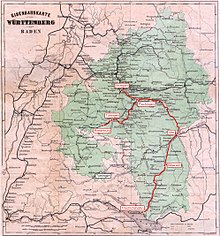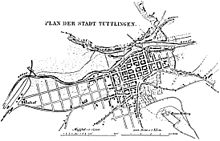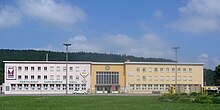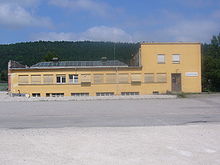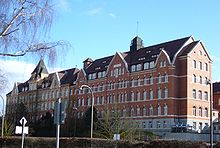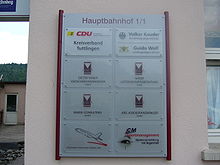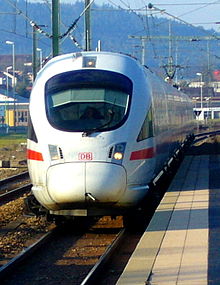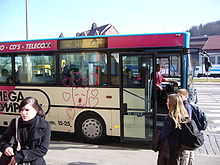Tuttlingen station
| Tuttlingen station | |
|---|---|
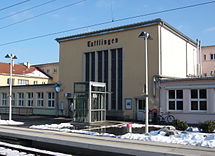 View of platform 1 and the reception building
|
|
| Data | |
| Location in the network | Crossing station |
| Platform tracks | 5 |
| abbreviation | TTU |
| IBNR | 8000163 |
| Price range | 3 |
| opening | September 29, 1933 |
| Architectural data | |
| Architectural style | Modernism of the Weimar period |
| architect | Building construction office of the Reichsbahndirektion Stuttgart |
| location | |
| City / municipality | Tuttlingen |
| country | Baden-Württemberg |
| Country | Germany |
| Coordinates | 47 ° 58 '48 " N , 8 ° 47' 54" E |
| Railway lines | |
| Railway stations in Baden-Württemberg | |
The Tuttlingen train station (also often called the main train station ) is the most important of a total of eight train stations in the Baden-Württemberg district town of Tuttlingen . The station was built from 1928 to 1933 at a new location, replacing the much smaller Tuttlingen railway station built in 1869. The station Tuttlingen is a railway junction at the intersection of railway line Stuttgart-Tuttlingen , with the railway line Tuttlingen-Inzigkofen and the railway Tuttlingen-Hattingen . It is connected to the Intercity network and one of the most important stations in the Ringzug system. It serves the Tuttlingen district as the most important hub in local public transport .
history
The train station from 1869
Connection of Tuttlingen to the railway
In the mid-19th century, Tuttlingen was on the outskirts of southern Württemberg, right on the border with Baden . Despite this border location, Tuttlingen was initially very conveniently located on the so-called Swiss Post Road , an important north-south road connection that led from Stuttgart to the Swiss border near Schaffhausen . In 1797, Johann Wolfgang von Goethe, among others, traveled on this busy road from Weimar to Switzerland via Tuttlingen. With the construction of the Württemberg main line from 1844 to 1850, however, the Swiss Post Road lost its importance and Tuttlingen its convenient location. This only changed when Württemberg added further routes to its main line and Tuttlingen came within the range of the new means of transport. In 1859, the Royal Württemberg State Railways built the Upper Neckar Railway to Reutlingen and through the Neckar Valley to the southwest, starting from the main line in Plochingen . First the railroad reached Tübingen , Rottenburg am Neckar , Horb am Neckar and Rottweil , from where they wanted to connect to the Black Forest Railway , which was under construction, and thus to the Baden route network. One of these connecting railways from Rottweil provided for a route via Tuttlingen, from where the Württemberg railway line was to continue to Immendingen in Baden , via which the Baden State Railways also planned the construction of the Black Forest Railway . Tuttlingen was connected to the railway network for the first time on July 15, 1869 via this connecting line and thus regained its favorable transport position, which it had lost two decades earlier.
Effects of the station building on urban development
Tuttlingen's first train station was located roughly where the roundabout at Aesculap-Platz is today, i.e. at the intersection of today's federal highways 14 and 311, far outside the settlement and the road network that existed at that time. The reason for this comparatively unfavorable location was that the railway line was primarily intended to serve as a connecting line to the Black Forest Railway, and the topographical conditions made it difficult to give the city a central station. The railway line followed the Prim , Faulenbach and Elta from Rottweil to the south and was to change from Tuttlingen to the west into the Danube valley and thus reach the Black Forest Railway Station in Immendingen . However, the settlement of Tuttlingen at that time was exclusively east of the confluence of the Elta and Danube, so that the railway line passed the Tuttlingen settlement and the train station had to be built well outside the Tuttling settlement structure. In order to connect Tuttlingen to its distant train station, the city extended what was then called Poststrasse from Rathausplatz to the train station. This street, which initially mainly led past fields and meadows, was given the function of the central axis between the center and the train station and was accordingly renamed Bahnhofstraße . In order to build Bahnhofstrasse, the Danube, which originally flowed through in the area of today's city garden, had to be straightened. The connection of Tuttlingen to the railway was also one of the reasons for the strong growth of the city, which now expanded mainly towards the west towards the train station. In 1867, two years before the railway connection, Tuttlingen still had 7,031 inhabitants, the number grew to 8,343 in 1883 and to 13,530 in 1900. The up-and-coming Tuttlingen-based company Jetter und Scheerer (now Aesculap AG ) settled in the emerging station district as a result of the railway construction, where it was easily accessible for commuters and the goods produced could easily be transported by rail. The rail connection played a significant role in the industrial development of Tuttlingen, which before the rail connection was largely characterized by agriculture and handicrafts .
Development of the Tuttlingen railway connection by 1890
The journey from Tuttlingen station to Stuttgart initially took about eight hours (today about an hour and 25 minutes on the IC), which was also due to the detour of the route via Horb, Tübingen and Plochingen. It was only with the completion of the Gäu Railway, i.e. the construction of a railway line from Freudenstadt via Eutingen im Gäu to Stuttgart in 1879, that a relatively straight line from Tuttlingen to the Württemberg state capital emerged. From the east, Tuttlingen could still not be reached by train. It was not until 1890 that the city became a railway junction and transfer station with the completion of the Tuttlingen – Inzigkofen railway . There was now a direct connection to Ulm, Stuttgart and via Immendingen to the Black Forest Railway. A connection to Singen (Hohentwiel) was only possible via the detour to Immendingen, where a change of direction was also necessary.
The train station from 1933
Background: The expansion of the Gäubahn
After the First World War , the People's State of Württemberg sought to expand its railways. For economic reasons, Württemberg was interested in traffic from Berlin to Switzerland passing through its territory and not exclusively via the neighboring states of Bavaria and Baden . Württemberg therefore set about expanding its part of a railroad line from Berlin via Würzburg , Stuttgart and Tuttlingen to Zurich . For this purpose, numerous expansion measures were decided on February 23, 1927 in a contract with the Deutsche Reichsbahn , which among other things led to the construction of a new Tuttlingen station. It was planned to fully expand the Gäubahn between Tuttlingen and Stuttgart to two tracks. The Gäubahn was not to end in Immendingen and connect there to the Black Forest Railway . Rather, they were interested in a straight north-south line from Stuttgart to the German-Swiss border in Singen. A single-track 8.2 km long connecting curve (so-called Hattinger curve ) was to lead from Tuttlingen to Hattingen on the Black Forest Railway, so that the detour via Immendingen was no longer necessary for traffic from Stuttgart to Switzerland.
Construction of the new train station 1928–1933
In the 1920s, the station from 1869 had already reached its capacity limit. An expansion of the old station was not possible due to its cramped location between the Danube , Ehrenberg and Weimarstrasse . The planned relocation of a second track towards Stuttgart in connection with the new line to Hattingen (Baden) was considered impossible on the old site. The Reichsbahndirektion Stuttgart , which was entrusted with the construction work, therefore decided to build a new station on the other side of the Danube another 200 m further from the city center, where there was sufficient development potential for the station. The bed of the Danube was relocated to a length of around 2 km in the Koppenland district , and the level of the new station area was raised with excavated material from the Wurmlingen forest area "Hölzle" 4 kilometers away .
Reichsbahndirektor Alfred Nägele from the Stuttgart Railway Directorate was responsible for the construction of the new station. The installation of the tracks began in the spring of 1932. This and other parts of the station system crossed the state border with Baden , so that the station was half in Württemberg and half in Baden. The station had eight tracks and additional loading tracks , a locomotive shed , a goods handling hall and a turntable . During the construction of the station, provisions were made at various points for a possible later station expansion, which, however, never came about. The station building was designed by the building construction office of the Reichsbahndirektion Stuttgart. It is in the style of the late 1920s and follows the tradition of modern building from the Weimar period . A special feature was the flat roof of the reception building, which is quite unusual for the Tuttlingen architecture. The station building has three floors and was one of the largest railway buildings in all of Württemberg at the time of construction. Although the building was planned by the Reichsbahndirektion Stuttgart before the National Socialist seizure of power , similarities with the monumental buildings of the National Socialist architecture are seen. The Tuttlingen station building has remained the largest railway building in the region to this day and is considered oversized for a city the size of Tuttlingen.
During the construction period between 1928 and 1933, an average of 280 workers a day found employment at Tuttlinger Bahnhof, which was an enormous relief for the local labor market , which was shaken by the global economic crisis . A total of 20,000 m³ of concrete , 900 tons of steel and 24.6 km of track were used at the new station . The total cost of the new station building amounted to 9 million Reichsmarks .
The station was officially opened on September 29, 1933. The celebration was strongly influenced by National Socialist propaganda , which took over the new train station. One of the speeches was given by the Württemberg State President and NSDAP - Gauleiter Wilhelm Murr . In addition, the director of the Reichsbahndirekt Stuttgart spoke. He justified the delay in the new building with high costs. They are caused by the austerity program that was practiced during the time of the Württemberg railways.
The facilities of the old station, which had lost its purpose, were dismantled in the months after the new station opened. The station building was demolished and some of the stones were used to build a house. In May 1934, the construction of the new single-track line to Hattingen was completed. However, there was never a complete double-track expansion of the Gäubahn. During the Second World War , work was stopped in 1941. The section from Oberndorf to Aistaig therefore remained a single track, just like the new section from Tuttlingen to Hattingen.
War damage in 1945, reparations payments and conversion to diesel operation
Of the total of five Allied air raids on Tuttlingen in February and March 1945, four were predominantly against the railway systems. The west wing of the reception building, the freight station, the locomotive shed and the track systems were badly damaged. After the capitulation in May 1945, civil rail traffic in Tuttlingen came to a complete standstill by June 1945. Since the German Wehrmacht blew up numerous bridges over the Danube in the last days of the war, large parts of the route to Inzigkofen remained closed until 1950. Trains that drove out of the French occupation zone in which Tuttlingen was located did not initially exist. It was not until 1948 that trains ran again from Tuttlingen to Stuttgart and Zurich. The direct connections from Tuttlingen to Berlin, for which the Gäubahn was expanded between 1928 and 1941, have not been taken up after the war to this day. It was not until 1957 that the last war damage was repaired at Tuttlingen station.
In 1946 the French occupying forces removed the second track on the Gäubahn between Tuttlingen and Horb am Neckar, which had only been laid a few years earlier, as a reparation payment . Since then, Tuttlingen has only been connected from all directions via single-track rail connections. Between 1955 and 1969, all routes in Tuttlingen were switched from steam to diesel operation .
Electrification, dismantling and sale of railway systems since the 1960s
In 1977 electrified the German Federal Railways the Gäubahn , resulting in journey time reductions Stuttgart and Zurich. On the route to Inzigkofen, diesel operation has remained to this day.
Since the 1960s, there have been numerous dismantling measures at Tuttlingen station, which, when it was built in the early 1930s, had been designed for possible expansion. Of the original eight tracks for passenger traffic, five are still there today. With the cessation of goods handling, the freight tracks and many points were dismantled. In 1992 the Federal Railroad sold the freight yard area to the city of Tuttlingen and the locomotive shed area to a railway enthusiast. Also in 1992, the railway sold the west wing of the station building to an insurance broker, who then renovated it and partly rented it out. The east wing, which remained with the Federal Railroad, was fundamentally renewed in 1994. The facade was not renovated, as was done on the west wing. The German railway closed in 1995, although the luggage counter, but it taught in the same year a travel center one.
The train station today
Tracks
- Track 1 is used for ring train traffic to Fridingen an der Donau and amplifier to Aldingen.
- Track 2 is used for regional and long-distance traffic on the Gäubahn from Stuttgart
- Track 3 is used for regional traffic to Ulm and for ring train traffic in the direction of Immendingen / Geisingen -Leipferdingen / Blumberg-Zollhaus
- Track 4 is used for regional traffic to Donaueschingen and the ring train traffic to Rottweil / Villingen and Bräunlingen
- Track 5 is used for regional and long-distance traffic on the Gäubahn towards Stuttgart
Length of the track
- Track 1
- Height 55 cm; Length 80 m | As the only track completely barrier-free, as only ring trains leave here
- Track 2
- Height 76 cm; Length 320 m | Only partially barrier-free for Ringzug-RS
- Track 3
- Height 76 cm; Length 320 m | Only partially barrier-free for Ringzug-RS
- Track 4
- Height 76 cm; Length 320 m | Only partially barrier-free for Ringzug-RS
- Track 5
- Height 76 cm; Length 320 m | Only partially barrier-free for Ringzug-RS
Entry with wheelchairs is only possible via a ramp (76 cm -> 55 cm)
location

The train station is about 2 km west of the old town on the edge of Tuttlingen's core city and connects to the Koppenland district and the allotment gardens there, as well as the Danube Cycle Path , to the west . The track structure extends to the former Baden district of Möhringen . The station forecourt east of the station is in the immediate vicinity of the Aesculap company , Tuttlingen's largest employer.
Train station or main train station?
The Tuttlingen train station is not one of the 116 German train stations that Deutsche Bahn designates as the main train station and is therefore called Tuttlingen . In Tuttlingen, however, the name Tuttlingen Hauptbahnhof is widely used to differentiate it from the abandoned former north station . On the signs of the city administration, for example, there are several references to the main train station. The address designation Hauptbahnhof 1 is also officially used as the address of the station building.
Use of the railway system for non-operational purposes
Large parts of the station building and the railway facilities are now privately owned and no longer have a railway operational function. The reception building is now divided into a railway area and a non-railway area, which are separated from each other by a glass wall. In the non-railway area, it is mainly catering establishments that have set up. In addition, Volker Kauder , the CDU member of the Bundestag, runs his constituency office in the west wing of the building together with the CDU member of the state parliament, Guido Wolf .
At the locomotive shed and the turntable of the train station, a private railway museum has meanwhile been built , which shows 26 mostly non-operational steam locomotives, mostly outdoors.
business
The station is a railway junction where the Gäubahn from Stuttgart to Singen (Hohentwiel) meets the railway lines to Inzigkofen and Immendingen. The Tuttlinger Bahnhof is a through station that is now used exclusively for passenger traffic. Goods handling no longer exists, but freight trains continue to pass the Tuttlingen station. The Intercity and Regional Express traffic is now operated by Deutsche Bahn , while the Ringzug and Naturpark Express are operated by the Hohenzollerische Landesbahn . The parts of the railway system that are still relevant for railway operations today are owned by DB Station & Service . Deutsche Bahn currently assigns the station to station category 3 as a long-distance stop and hub for regional traffic .
IC Stuttgart – Tuttlingen – Zurich
On the Gäubahn Tuttlingen stop is in hourly trains running intercity between Stuttgart and Zurich or singing . Tuttlingen is served daily by a total of seven pairs of trains, which are connected to Zurich, as well as a further 8, which make the hourly service with a change in Singen. Mon-Fri two pairs of trains are tied to Konstanz ; all trains can be used to Singen / Konstanz at the local transport tariff . The IC are in Tuttlingen in knots on the hour with connection to the ring trains to Rottweil and Geisingen-Leipferdingen or Blumberg-Zollhaus. For cross-border traffic, wagon trains from locomotives of the 1016 or 1116 series of the ÖBB and EC wagons of the SBB are provided, the domestic German connections are operated with Intercity 2 .
| line | path | frequency |
|---|---|---|
| IC 87 | Stuttgart - Singen - Zurich | Hourly |
Regional Express
Regional Express trains (RE) run every two hours between Ulm and Donaueschingen. At the weekend, a pair of trains runs per day instead of an IC 2 as "Radexpress Bodensee" to meet the need for high bicycle parking spaces.
During the school holidays in Baden-Württemberg , two pairs of trains also run as the Danube Valley Holiday Express from Immendingen to Ulm; the trains are operated jointly by HzL and DB RAB .
| line | frequency | |
|---|---|---|
| RE |
DONAUTALBAHN Ulm - Sigmaringen - Tuttlingen - Donaueschingen - Neustadt (Black Forest) |
Two-hour intervals |
| RE4 |
Radexpress Bodensee Stuttgart - Böblingen - Herrenberg - Horb - Rottweil - Tuttlingen - Singen (Hohentwiel) - Constance |
Sat and Sun a pair of trains |
Ring train, Nature Park Express and links to intercity bus services
The station is one of a total of eight stops on the ring train in the area of the city of Tuttlingen. This connects every hour on weekdays and every two hours on weekends with Immendingen and from there via the Wutachtalbahn to Geisingen -Leipferdingen. Some ring trains run via Leipferdingen to Blumberg , especially on weekends . On the Gäubahn, the ring train travels via Spaichingen to Rottweil and from there normally every two hours to Bräunlingen .
In the ring train system, Tuttlingen station is a zero node , which means that the ring trains from Rottweil cross here at minute zero with the ring trains from Leipferdingen, where a few minutes after the ring trains arrive, some intercity bus routes, for example to Trossingen and in the direction of Sigmaringen, leave. Shortly before the arrival of the ring trains in Tuttlingen, the intercity buses reach Tuttlingen station, where there are optimal connections to other buses as well as to the ring trains in the direction of Rottweil and Leipferdingen.
At Tuttlingen station, the branch to Fridingen an der Donau branches off the main line of the ring train ( Tuttlingen – Inzigkofen line ). There, however, the Ringzug traffic is not synchronized. Only individual trains run on weekdays. There is no ring train traffic there on weekends. Between May and October, Tuttlingen is also a stop of the Nature Park Express , which connects Tuttlingen with the Obere Donau and Gammertingen Nature Park with a connection to the RadWanderShuttle to Engstingen in the east and in the west with Blumberg on the Wutachtalbahn museum railway and primarily targets tourist needs.
| line | path |
|---|---|
| HZL | Rottweil - Tuttlingen - Immendingen - Blumberg customs house |
| HZL | (Aldingen near Spaichingen - Spaichingen) - Tuttlingen - Mühlheim an der Donau - Fridingen |
| HZL Nature Park Express | Blumberg Customs House - Geisingen-Leipferdingen - Immendingen - Tuttlingen - Fridingen - Sigmaringen |
Connection to the city bus service
Since the Tuttlingen train station is well outside the city center and larger residential areas, many passengers need to continue their journey by bus . In city traffic there is a 15-minute basic cycle to the central bus station in the city center, both on weekdays and on weekends , up to which all city and intercity bus routes run in parallel. This basic cycle of four buses per hour is supplemented by numerous additional buses on weekdays.
Link with individual traffic
The Danube Cycle Path , which is important for tourism, connects directly to the east of the train station . However , there is no cycle path to the city center via Bahnhofstrasse . Rather, cyclists have to cross or under Aesculap-Platz, the intersection of two busy federal roads , to get to the city center. An unsupervised bicycle parking space is available at the train station. The construction of a bike station at the train station is a project of the Local Agenda 21 . Due to the close proximity of two important federal highways, the station is well connected to the road network. Free parking spaces are available for train drivers.
Barrier-free access
Deutsche Bahn assigns the Tuttlingen station to the partially barrier-free stations. In addition to the stairs, there are also lifts to access the platforms. However, since platforms 2 to 5, which are mainly used, do not allow barrier-free access with a platform height of 76 cm, only platform 1, which is used sporadically, can be used completely barrier-free. To make matters worse, the trains of the series 411 and 611 stopping in Tuttlingen as well as n-Wagen and Naturpark-Express are not barrier-free, so that wheelchair users can usually not get on or off in the station without outside help. Completely barrier-free access is now only available for the ring trains to Fridingen, which occasionally leave platform 1 .
Literature and sources used
- Deutsche Bundesbahn Bundesbahndirektion Stuttgart press service: 50 years of the new station, 113 years of the railroad in Tuttlingen: A historical look back, days of the DB on October 8 and 9, 1983 at Tuttlingen station . Stuttgart 1983.
- Jens Herzbruch: How it became what it is: Tuttlingen - the planned city, work as part of the practical vocational studies I at the Kassel University, winter semester 1986/87 . (unpublished)
- Richard people: The history of the railways in the Tuttlingen area . In: Tuttlinger Heimatblätter . Volume 46, 1983, pp. 46-63.
- Richard people: The railway in the Tuttlingen area . In: Hans-Wolfgang Scharf, Burkhard Wollny: The Gäubahn from Stuttgart to Singen . EK-Verlag, Freiburg im Breisgau 1992, pp. 200-215. ISBN 3-88255-701-X
- Richard People: The railways in the Tuttlingen area after the Second World War . In: Tuttlinger Heimatblätter . Volume 61, 1998, pp. 144–156.
- Birgit Schocker: Everyday Life in Tuttlingen 1939 to 1945/46 . Tuttlingen 1995, pp. 49-52.
- City of Tuttlingen (ed.): On the history of the city of Tuttlingen . Tuttlingen 1997.
- City of Tuttlingen (Ed.): Discover Tuttlingen . Tuttlingen 2004, p. 84.
- Gunda Woll: "In a mad hurry" - Mobility in Tuttlingen In: Tuttlinger Heimatblätter . Volume 68, 2005, pp. 85-104.
- Zweckverband Ringzug Schwarzwald-Baar-Heuberg (Hrsg.): The 3er Ringzug: An investment for the future of the Schwarzwald-Baar-Heuberg region . Villingen-Schwenningen, 2006, p. 63.
Web links
- Location, tracks, signals and permissible speeds of the station on the OpenRailwayMap
- Construction plans in the Ludwigsburg State Archives
- Information from the DB Station & Service to the train station
- Reichsbahn timetable Stuttgart – Tuttlingen – Immendingen 1944/45
- Reichsbahn timetable Immendingen – Tuttlingen – Ulm 1944/45
Individual evidence
- ^ Albert Kuntzemüller : The Baden Railways 1840-1940, self-published by the Geographical Institutes of the Universities of Freiburg i. Br. And Heidelberg, Freiburg im Breisgau 1940, p. 119
- ↑ Some trains in the daytime area only go to Sigmaringen or Aulendorf, in the other direction the trains sometimes end in Immendingen, Donaueschingen, or continue on the Black Forest Railway to Villingen
